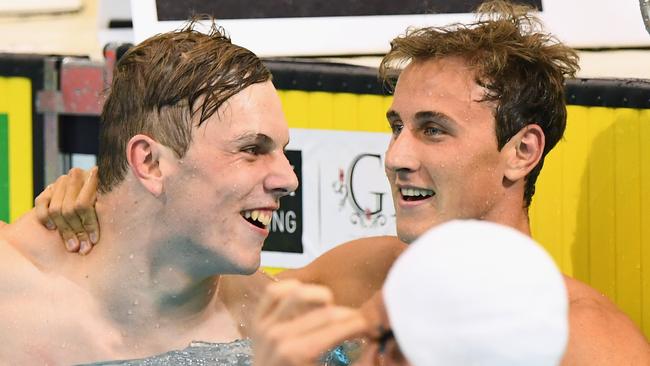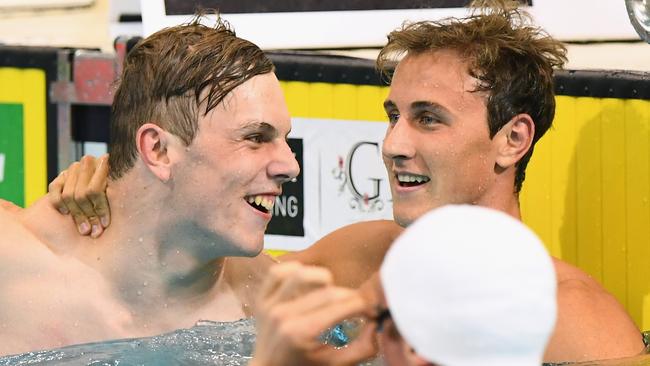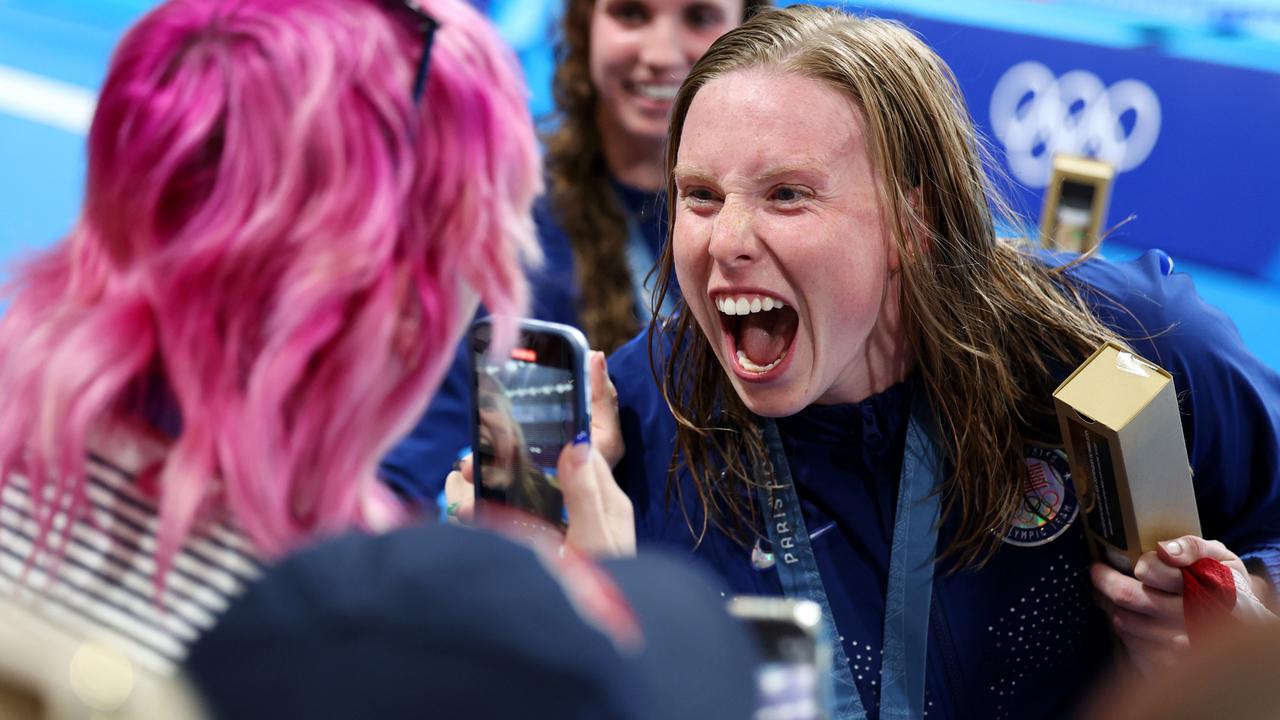Adelaide swimmer Kyle Chalmers becomes most marketable young stars in Australian sport after Rio Games selection
THE stars are starting to align rapidly for Adelaide swimming star Kyle Chalmers after winning selection in Australia’s squad for the Rio Olympics.

Swimming
Don't miss out on the headlines from Swimming. Followed categories will be added to My News.
- Why Kyle Chalmers is Australia’s next great swimmer
- Ian Thorpe backs Adelaide’s swimming superstar Kyle Chalmers
KYLE Chalmers’ Rio Olympic selection will have him become one of the most marketable young stars in Australian sport as the national swim team stamps him as not only a face of the future, but a leader.
At 17, he already has a lucrative long-term deal with global sportswear company Adidas and his management company is already planning for Tokyo in 2020 and beyond.
On Tuesday the Adelaide star will fly to Sydney as one of swimming’s two representatives at the launch of the Australian Olympic team’s Adidas tracksuit unveiling.
There he will stand alongside some of Australian sport’s biggest names including Olympic hurdles champion Sally Pearson who also belongs to the Adidas stable.
But despite that, and a new swimmers’ fund backed by mining magnate Gina Rinehart which is designed to ease the financial pain of the nation’s elite swimmers, any million-dollar payday is a long way off and will come only with winning Olympic gold — particularly individual gold which Chalmers will realistically target in Tokyo.
Chalmers’ management company TLA Worldwide would not reveal the level of corporate interest in their young star who booked his ticket to the Rio Olympics by finishing second in the men’s 100m freestyle final at the trials this week.

But don’t expect him to become a walking billboard on the road to Rio, with his manager Peter Nicholls saying the plan was for Chalmers to work with a select few long-term partners over the duration of his swimming career.
TLA had been monitoring Chalmers for two years, before signing him at the start of 2015 following a recommendation from fellow sprinter Eamon Sullivan.
“The goal is for Kyle to work with a small number of long-term partners over the journey, and we believe with Rio, a home Commonwealth Games in 2018 and Tokyo Olympics in a friendly time zone for Australia, there will be ample opportunities for brands and partners to leverage an association with elite athletes over the next four-year period,” Mr Nicholls said.
“Kyle will appeal to all sponsors in the same way all elite athletes do — with storylines around high performance, world’s best practice, success, leadership, inspiration and goal-setting.”
Chalmers signed with Adidas at the same age as Ian Thorpe when he signed on to wear its revolutionary skinsuit in 1999.
Thorpe remained with Adidas throughout his stellar international career in a deal which at its height was believed to net him more than $500,000 a year.
Chalmers’ contract with Adidas is likely to be only a fraction of that, however Swimming Australia insiders say it would most likely be incentive based and would grow as he begins to shine on the international stage.

At the height of Grant Hackett’s career, he had major deals with Holden and Speedo at a time when some top swimmers could command as many as four sponsors at $250,000 each.
Mr Nicholls said the Adidas sponsorship deal was “significant” because it allowed Chalmers to plan long-term for Tokyo and beyond.
“Financially it will not be as much of a challenge for him to compete and fund his sport and as such the temptation to try another sport isn’t as prevalent,” Mr Nicholls said.
Not all swimmers however are as fortunate.
While the average wage of an AFL footballer is $300,000 a year, some of Australia’s elite swimmers just two years ago were on as little as $20,000 before any major sponsorship and endorsement deals — if they could get them.
“It’s almost impossible unless you win an Olympic gold medal,” Swimming Australia president John Bertrand said.
Which is why Mrs Rinehart’s contribution to a new swimmers’ fund has been so welcomed by Swimming Australia and its athletes.
Mr Bertrand would not reveal how much money its top swimmers were now being paid but said “it’s taken a huge amount of hurt out of the equation.”
“There are two areas of contribution through Hancock Prospecting and through the Georgina Hope Foundation, there are finances going into a swimmers’ fund which alleviates a huge amount of the financial stress that our swimmers undergo as a result of families having to fund these kids,” Mr Bertrand said.
“Basically these Olympic sports including swimming are amateur compared to AFL or cricket and so on, because of television rights ... we work in a different world.
“Mrs Rinehart’s contribution has been an enormous sea change for swimmers in this country.
“And the life changes that those financial assistances have made have been incredible, some of the letters I’ve seen (written) back to Mrs Rinehart, it’s beautiful stuff.”
Chalmers turned his back on a promising football career to pursue swimming and Mr Bertrand said Swimming Australia had already identified him as a future leader of its team.
“Kyle comes from the world of football and what we noticed in Kazan (world championships last year) was that people were gravitating around Kyle,” Mr Bertrand said.
“He is a natural leader, he loves the team environment and it’s clear that he probably loves the relays more than the individual events because it’s a team.
“Now that’s a perfect kind of person to have in an organisation.
“Even though he’s only a 17-year-old kid, he’s a natural leader and that’s exciting for the organisation.”
By qualifying for the Rio Olympics in 48.03 secs this week, Chalmers became the sixth fastest Australian 100m freestyler ever behind emerging superstar Cameron McEvoy (47.03), Sullivan (47.05), James Magnussen (47.10), James Roberts (47.63) and Matt Targett (47.88) — but quicker than Michael Klim who did 48.18 at the Sydney 2000 Olympics.
He also has the sixth fastest 100m freestyle time in the world so far this year and his Olympic selection will make him one of South Australia’s most high-profile athletes.
In Rio he will become the first South Australian swimmer to compete at an Olympics since Sally Hunter and Hayden Stoeckel — who won a silver and two bronze medals in Beijing and London.
reece.homfray@news.com.au
Originally published as Adelaide swimmer Kyle Chalmers becomes most marketable young stars in Australian sport after Rio Games selection


